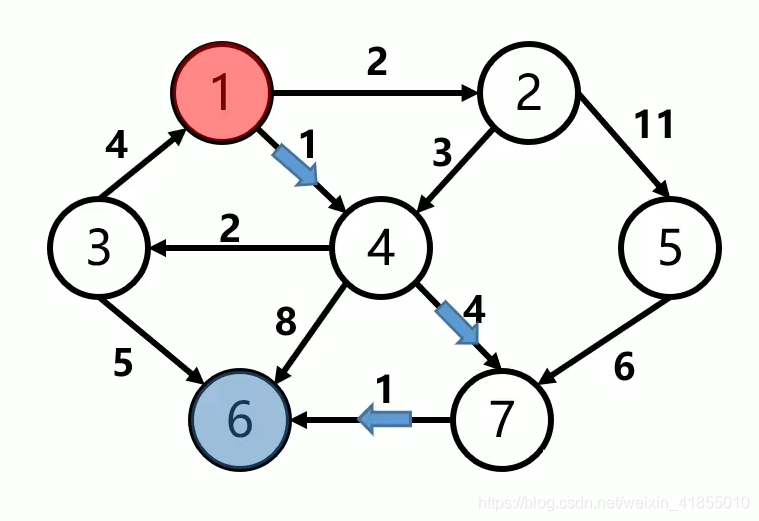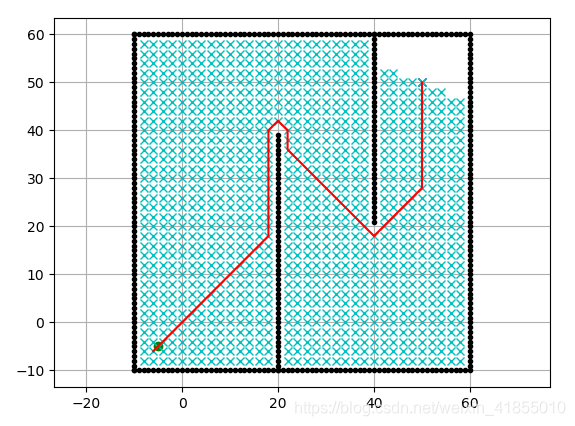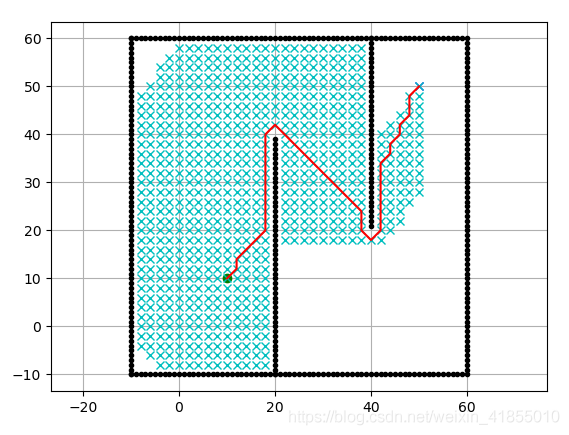一文教你用python编写Dijkstra算法进行机器人路径规划
为了机器人在寻路的过程中避障并且找到最短距离,我们需要使用一些算法进行路径规划(Path Planning),常用的算法有Djikstra算法、A*算法等等,在github上有一个非常好的项目叫做PythonRobotics,其中给出了源代码,参考代码,可以对Djikstra算法有更深的了解。
一、算法原理

如图所示,Dijkstra算法要解决的是一个有向权重图中最短路径的寻找问题,图中红色节点1代表起始节点,蓝色节点6代表目标结点。箭头上的数字代表两个结点中的的距离,也就是模型中所谓的代价(cost)。
贪心算法需要设立两个集合,open_set(开集)和closed_set(闭集),然后根据以下程序进行操作:
- 把初始结点放入到open_set中;
- 把open_set中代价最小的节点取出来放入到closed_set中,并且作为当前节点;
- 把与当前节点相邻的节点放入到open_set中,如果代价更小更新代价
- 重复2-3过程,直到找到终点。
注意open_set中的代价是可变的,而closed_set中的代价已经是最小的代价了,这也是为什么叫做open和close的原因。
至于为什么closed_set中的代价是最小的,是因为我们使用了贪心算法,既然已经把节点加入到了close中,那么初始点到close节点中的距离就比到open中的距离小了,无论如何也不可能找到比它更小的了。
二、程序代码
"""
Grid based Dijkstra planning
author: Atsushi Sakai(@Atsushi_twi)
"""
import matplotlib.pyplot as plt
import math
show_animation = True
class Dijkstra:
def __init__(self, ox, oy, resolution, robot_radius):
"""
Initialize map for a star planning
ox: x position list of Obstacles [m]
oy: y position list of Obstacles [m]
resolution: grid resolution [m]
rr: robot radius[m]
"""
self.min_x = None
self.min_y = None
self.max_x = None
self.max_y = None
self.x_width = None
self.y_width = None
self.obstacle_map = None
self.resolution = resolution
self.robot_radius = robot_radius
self.calc_obstacle_map(ox, oy)
self.motion = self.get_motion_model()
class Node:
def __init__(self, x, y, cost, parent_index):
self.x = x # index of grid
self.y = y # index of grid
self.cost = cost
self.parent_index = parent_index # index of previous Node
def __str__(self):
return str(self.x) + "," + str(self.y) + "," + str(
self.cost) + "," + str(self.parent_index)
def planning(self, sx, sy, gx, gy):
"""
dijkstra path search
input:
s_x: start x position [m]
s_y: start y position [m]
gx: goal x position [m]
gx: goal x position [m]
output:
rx: x position list of the final path
ry: y position list of the final path
"""
start_node = self.Node(self.calc_xy_index(sx, self.min_x),
self.calc_xy_index(sy, self.min_y), 0.0, -1)
goal_node = self.Node(self.calc_xy_index(gx, self.min_x),
self.calc_xy_index(gy, self.min_y), 0.0, -1)
open_set, closed_set = dict(), dict()
open_set[self.calc_index(start_node)] = start_node
while 1:
c_id = min(open_set, key=lambda o: open_set[o].cost)
current = open_set[c_id]
# show graph
if show_animation: # pragma: no cover
plt.plot(self.calc_position(current.x, self.min_x), self.calc_position(current.y, self.min_y), "xc")
# for stopping simulation with the esc key.
plt.gcf().canvas.mpl_connect(
'key_release_event',
lambda event: [exit(0) if event.key == 'escape' else None])
if len(closed_set.keys()) % 10 == 0:
plt.pause(0.001)
if current.x == goal_node.x and current.y == goal_node.y:
print("Find goal")
goal_node.parent_index = current.parent_index
goal_node.cost = current.cost
break
# Remove the item from the open set
del open_set[c_id]
# Add it to the closed set
closed_set[c_id] = current
# expand search grid based on motion model
for move_x, move_y, move_cost in self.motion:
node = self.Node(current.x + move_x,
current.y + move_y,
current.cost + move_cost, c_id)
n_id = self.calc_index(node)
if n_id in closed_set:
continue
if not self.verify_node(node):
continue
if n_id not in open_set:
open_set[n_id] = node # Discover a new node
else:
if open_set[n_id].cost >= node.cost:# This path is the best until now. record it!open_set[n_id] = node
rx, ry = self.calc_final_path(goal_node, closed_set)
return rx, ry
def calc_final_path(self, goal_node, closed_set):
# generate final course
rx, ry = [self.calc_position(goal_node.x, self.min_x)], [
self.calc_position(goal_node.y, self.min_y)]
parent_index = goal_node.parent_index
while parent_index != -1:
n = closed_set[parent_index]
rx.append(self.calc_position(n.x, self.min_x))
ry.append(self.calc_position(n.y, self.min_y))
parent_index = n.parent_index
return rx, ry
def calc_position(self, index, minp):
pos = index * self.resolution + minp
return pos
def calc_xy_index(self, position, minp):
return round((position - minp) / self.resolution)
def calc_index(self, node):
return (node.y - self.min_y) * self.x_width + (node.x - self.min_x)
def verify_node(self, node):
px = self.calc_position(node.x, self.min_x)
py = self.calc_position(node.y, self.min_y)
if px < self.min_x:
return False
if py < self.min_y:
return False
if px >= self.max_x:
return False
if py >= self.max_y:
return False
if self.obstacle_map[node.x][node.y]:
return False
return True
def calc_obstacle_map(self, ox, oy):
self.min_x = round(min(ox))
self.min_y = round(min(oy))
self.max_x = round(max(ox))
self.max_y = round(max(oy))
print("min_x:", self.min_x)
print("min_y:", self.min_y)
print("max_x:", self.max_x)
print("max_y:", self.max_y)
self.x_width = round((self.max_x - self.min_x) / self.resolution)
self.y_width = round((self.max_y - self.min_y) / self.resolution)
print("x_width:", self.x_width)
print("y_width:", self.y_width)
# obstacle map generation
self.obstacle_map = [[False for _ in range(self.y_width)]
for _ in range(self.x_width)]
for ix in range(self.x_width):
x = self.calc_position(ix, self.min_x)
for iy in range(self.y_width):
y = self.calc_position(iy, self.min_y)
for iox, ioy in zip(ox, oy):
d = math.hypot(iox - x, ioy - y)
if d <= self.robot_radius:self.obstacle_map[ix][iy] = Truebreak
@staticmethod
def get_motion_model():
# dx, dy, cost
motion = [[1, 0, 1],
[0, 1, 1],
[-1, 0, 1],
[0, -1, 1],
[-1, -1, math.sqrt(2)],
[-1, 1, math.sqrt(2)],
[1, -1, math.sqrt(2)],
[1, 1, math.sqrt(2)]]
return motion
def main():
print(__file__ + " start!!")
# start and goal position
sx = -5.0 # [m]
sy = -5.0 # [m]
gx = 50.0 # [m]
gy = 50.0 # [m]
grid_size = 2.0 # [m]
robot_radius = 1.0 # [m]
# set obstacle positions
ox, oy = [], []
for i in range(-10, 60):
ox.append(i)
oy.append(-10.0)
for i in range(-10, 60):
ox.append(60.0)
oy.append(i)
for i in range(-10, 61):
ox.append(i)
oy.append(60.0)
for i in range(-10, 61):
ox.append(-10.0)
oy.append(i)
for i in range(-10, 40):
ox.append(20.0)
oy.append(i)
for i in range(0, 40):
ox.append(40.0)
oy.append(60.0 - i)
if show_animation: # pragma: no cover
plt.plot(ox, oy, ".k")
plt.plot(sx, sy, "og")
plt.plot(gx, gy, "xb")
plt.grid(True)
plt.axis("equal")
dijkstra = Dijkstra(ox, oy, grid_size, robot_radius)
rx, ry = dijkstra.planning(sx, sy, gx, gy)
if show_animation: # pragma: no cover
plt.plot(rx, ry, "-r")
plt.pause(0.01)
plt.show()
if __name__ == '__main__':
main()
三、运行结果

四、 A*算法:Djikstra算法的改进
Dijkstra算法实际上是贪心搜索算法,算法复杂度为O( n 2 n^2 n2),为了减少无效搜索的次数,我们可以增加一个启发式函数(heuristic),比如搜索点到终点目标的距离,在选择open_set元素的时候,我们将cost变成cost+heuristic,就可以给出搜索的方向性,这样就可以减少南辕北辙的情况。我们可以run一下PythonRobotics中的Astar代码,得到以下结果:

总结
到此这篇关于python编写Dijkstra算法进行机器人路径规划的文章就介绍到这了,更多相关python写Dijkstra算法内容请搜索本站以前的文章或继续浏览下面的相关文章希望大家以后多多支持本站!
版权声明:本站文章来源标注为YINGSOO的内容版权均为本站所有,欢迎引用、转载,请保持原文完整并注明来源及原文链接。禁止复制或仿造本网站,禁止在非www.yingsoo.com所属的服务器上建立镜像,否则将依法追究法律责任。本站部分内容来源于网友推荐、互联网收集整理而来,仅供学习参考,不代表本站立场,如有内容涉嫌侵权,请联系alex-e#qq.com处理。
 关注官方微信
关注官方微信